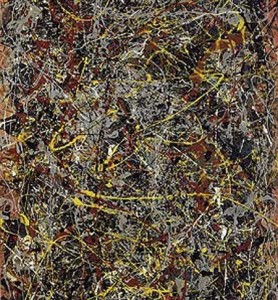Have you ever found yourself in a moment where you question everything? Where you reconsider everything you thought you knew? Well that happened to me today as I was reading one of the books I’m using for my research paper, Talking Prices. This book is an examination into the world of pricing contemporary art. As I read, I began to think about how much the art world is concerned with money… and how much I am not. Now, I know money is important and that it’s involved in almost every aspect of our lives, but I’m not interested in art for a profit. I love art, plain and simple. I love the feeling I when I discover a new artist, or when I see a work in a museum that I have studied in an art history course (ask Kelley about our visit to the National Gallery in London). I’m sure most people who are established gallery owners, dealers or curators thought the same thing, that they would never let their artistic priorities be compromised by commercial objectives or let financial matters interfere with the way they establish relationships with artists, but I’m sure that has changed. In a discipline where one is constantly bombarded with words like ‘provenance’, ‘price’ and ‘worth’ how could you not let it affect the way you see art? I am still leaning how art is priced, and I am still amazed that one painting can sell for one hundred and forty million dollars (Jackson Pollock’s No. 5, 1948). While selling prices at auction houses like Sotheby’s are fascinating, I don’t think it’s the only way to determine worth. One of my big questions is, how does the price of a work relate to its aesthetic quality? Call me naive, but I don’t want to turn into another person who just sees a big price tag instead of a work of art. But the end of my interview session with Norwich gallery owners I hope to have a few of my fears confirmed or laid to rest. In these interviews I have been trying to determine what kind of contemporary art market Norwich has. So far it seems to be a mix of so-called ‘traditional’ and ‘avant-garde’ spaces, quite like the inhabitants of this ‘fine city’. While some gallery owners have said there is a decent market in town, others are less than optimistic. I received an email from one of my contacts yesterday that stated, in fact, there is NO market for contemporary art in Norwich.
“As well as owning the gallery, I am an architect and it is this profession that has kept the gallery going. I’ve been working in Jersey (Channel Islands) for the last year, which is why the gallery has only had 2 shows in the last year…so the simple answer to your question is that contemporary art does not sell in a place like Norwich!”
But I still have hope! We’ll see if my constant optimism proves to be my demise.
Another realization: (and this is one that seems to be true across the boards) the more I learn about life, that more it seems that it’s not WHAT you know but WHO you know. Even with a Dickinson education, networking is essential. The whole art business is a giant web of relationships between artists, dealers and collectors. Lucky for me, I’ve inherited my father’s schmoozing skills and the ability to make friends easily. Now it’s time to put them to good use. People always tell you that best job is one that doesn’t feel like work, and I hope I can achieve this someday. But for now I’m going to have to work my way up the ladder. The art world is no place for introverts and if you want to stand out, you need to start networking early. Sound cutthroat? That’s because it is.


2 responses so far ↓
hankreas12 // Feb 19th 2010 at 19:14
That last paragraph is key. Networking is important no matter what field you are going into but I would imagine it is especially important in the art world. I like the hyperlinks by the way. Interesting post!
Karl // Feb 21st 2010 at 10:02
I too hope you don’t become fixated with price as the only indicator of worth. Aesthetic beauty is quite individual, so it seems that the monetary value of any piece is only what the wealthiest admirer would pay for it. I recently went to an exhibit at the Forum. There were many wonderful pieces by local artists, but for the life of me I could not figure out how they priced their art. It seemed to have nothing to do with the kind or quantity of materials, size of the piece, or the intricacy of the skills employed.
You must log in to post a comment.